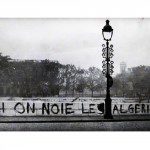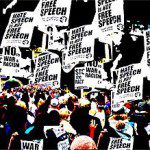Je Suis Charlie
Reflecting on the deaths of France's Charlie Hebdo journalists—and the freedoms they fought for
By now you all have heard the horrific news: Twelve people were killed at the Charlie Hebdo newspaper headquarters in Paris earlier today. At 11:30 a.m., local time, three men dressed in black emerged from a vehicle in front of the newspaper’s office, carrying automatic weapons. The gunmen stormed through, killing two police officers and eight journalists—including Hebdo editor, Stéphane Charbonnier (“Charb”) and cartoonists Bernard Verlhac (“Tignous”) and Jean Cabut (“Cabu”). According to raw video footage shot from a nearby building, the gunmen were overheard shouting, “We avenged the Prophet Mohammed! We killed Charlie Hebdo.”
The shooting is being described as the worst militant attack in France in decades. French President François Hollande referred to it as a “terrorist attack” and placed the country in its highest level of terrorism alert. Hollande noted that other attacks have been prevented in France in recent weeks.
As the world mourns the loss of these twelve lives, these events have sparked conversations in newsrooms, on the streets and online, about freedom of speech and freedom of the press.
A left-wing weekly, Charlie Hebdo is not new to controversy and skewering religious leaders and politicians. In 2011, the magazine made headlines for publishing an issue “guest-edited” by the Prophet Mohammed. Soon after, their offices were firebombed. But the magazine’s cartoonists and editorial board didn’t back down. In addition, their website has been hacked and they have been accused of blasphemy. Since those 2011 attacks, police bodyguards accompanied Charbonnier at all times.
Charlie Hebdo prided itself in provoking debate and commentary on world affairs. Their cartoonists were journalists, many of whom also wrote thought-provoking columns. The pen was their means of expression. It is important to note that they didn’t only target radical Islam. Some of their infamous covers include former Pope Benedict XVI embracing a Vatican guard and an Orthodox Jew kissing a Nazi soldier.
These journalists were not provoking for the sake of provocation. They were trying to prove a point through their cartoons: that by respecting these taboos, we are only serving to strength the power of censorship. A strong democracy is a place where opposing views are accepted and embraced.
Today, people turned to social media to express their anger in frustration regarding this senseless act and created the hashtag #JeSuisCharlie and #CharlieHebdo. Cartoonists around the world responded in solidarity, and Ottawa-based satirical publication Frank, responded by changing its logo to that of Charlie Hebdo’s. Michael Bate, the magazine’s editor, also stated that it’s going to run some of Charlie Hebdo’s cartoons.
So what sparked today’s attack?
The reasons behind today’s carnage remain unknown, with the hunt to find those responsible for the crime ongoing. But many media outlets have hinted to Charlie Hebdo’s current cover, a cartoon of a new controversial book recently published by French author Michel Houllebecq, Submission, where the author imagines France run by an Islamic party in the future.
Charbonnier famously said, after the attacks in 2011, that his job was not to defend freedom of speech, but without freedom of speech we are dead. He was a man who would not be silenced. “I prefer to die than to live like a rat,” he said.
Journalism is experiencing difficult times. We are now living in a world where ordinary citizens claim to be journalists, and where professional journalists continue to face severe cuts from news organizations as well as deal with the reality of increasingly concentrated media ownerships.
Are today’s attacks proof of the price to pay for journalism? The individuals who died today stood up for freedom of speech and freedom of the press until the very end—because freedom of the press will only disappear if we stop using it altogether.















